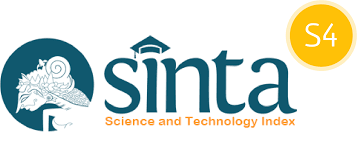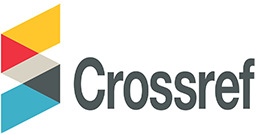Pengaruh Cercospora sp. terhadap Kandungan Asam Askorbat pada Mekanisme Patogenisitas Bercak Daun Tanaman Cabai : Kajian secara In Vitro dan In Planta
Pengaruh Cercospora sp. terhadap Kandungan Asam Askorbat pada Mekanisme Patogenisitas Bercak Daun Tanaman Cabai : Kajian secara In Vitro dan In Planta
Abstract
Red chili is a vegetable commodity that has high economic value in Indonesia. Leaf spot disease caused by the fungus Cercospora sp. is one of the limiting factors in red chili production. The occurrence of leaf spot disease is determined by the success of the pathogenesis by the fungus Cercospora sp. In addition, red chilies that are resistant to leaf spot disease have higher ascorbic acid content than vulnerable red chilies. The purpose of this study was to determine the ability to grow pathogens Cercospora sp. on the medium which was given ascorbic acid and know the effect of inoculation of the pathogen Cercospora sp. against ascorbic acid content in red chili leaves (C. annuum L.). This study used an experimental design with a completely randomized design (CRD). In vitro tests carried out consisted of PDA and PDB medium which were given ascorbic acid with a concentration of 0 mg.l-1, 0,25 mg.l-1, 0,5 mg.l-1, 0,75 mg.l-1 and 1,0 mg.l-1. In planta testing was using hot chili red chili varieties, large red chili varieties and curly red chili varieties. The treatments that were tested included calculation of disease intensity and ascorbic acid content in red chili leaves. In vitro test the main parameters observed were the diameter colony of the fungus Cercospora sp. dan mycelium dry weight. In planta test the main parameters observed were the intensity of the disease, while the supporting parameters were the incubation period of the disease, the content of ascorbic acid in the red chili leaves, temperature and humidity. In vitro test data obtained were analyzed using Analysis of Variance (ANOVA) at a 95% confidence level, then the treatment that gave a real or very real difference was followed by the Least Significant Difference test (LSD). In planta test data obtained were analyzed using Analysis of Variance (ANOVA) at a 95% confidence level, then the treatment that gave a real or very real difference was followed by the Least Significant Difference test (LSD). The results showed that the pathogen Cercospora sp. able to grow well on the PDA medium and GDP medium which were given ascorbic acid. Inoculation of pathogen Cercospora sp. can increase ascorbic acid content in red chili leaves.
References
Agung, S. 2016. Efektivitas Ekstrak Daun Mimba, Mengkudu, Jarak, Sirih dan Serai sebagai Biofungisida Penyebab Penyakit Antraknosa (Colletotrichum gloeosporioides) pada Jambu Biji (Psidium guajava) Secara In Vitro. Skripsi. Jurusan Agroteknologi Fakultas Pertanian Universitas Lampung.
Almatsier, S. 2004. Prinsip Dasar Ilmu Gizi. Jakarta: Gramedia Pustaka Umum.
Ayua, E., Mugalavai, V., Simon, J., Weller, S., Obura, P., & Nyabinda, N. 2016. Ascorbic Acid Content in Leaves of Nightshade (Solanums sp.) and Spider Plant (Cleome gynandra) Varieties Grown Under Different Fertilizer Regimes in Western Kenya. African Journal of Biotechnology, 15(7): 199-206.
Badriyah, L., & Manggara, A. B. 2015. Penetapan Kadar Vitamin C pada Cabai Merah (Capsicum Annuum L.) menggunakan Spektrofotometri UV-Vis. Jurnal Wiyata, 2(1): 25-28.
Barth, C., De-Tullio, M., & Conklin, P. L. 2006. The Role of Ascorbic Acid in the Control of Flowering Time and the Onset of Senescence. Journal of Experimental Botany, 57(8): 1657-1665.
Bhat, F. A., Dar, G. M., Tell, M. A., & Akmad, M. F. 2008. Froreye Leaf Spot of Bell Pepper in Kashmir: Prevalence and Cause. Kartanataka J Agric Sci, 21(3): 460-461.
Bhat, F. A., Tell, A. M., Ahmad, N. Q., & Ahmed, S. 2009. Host Range an Epidemiology of Cercospora Capsici. International Journal of Plant Sciences, 4(1): 44-48.
Bosland, P. W., & Votava, E. J. 1999. Peppers : Vegetable and Spice. Capsicum sp. London: CABI publ.
Choi, Y. W., Hyde, K. D., & Ho, W. H. 1999. Single Spore Isolation of Fungi. Journal Fungla Divers, 3: 29-38.
Dharmaputra, O. S., Agustin, W. G., & Nampiah. 1989. Penuntun Praktikum: Mikologi Dasar. Departemen Pendidikan dan Kebudayaan. Direktorat Jendral Pendidikan Tinggi Pusat Antar Universitas Ilmu Hayati. Bogor: IPB.
Fuadi, I., & Yusuf, R. 2005. Penerapan Sistem Pengendalian Hama Terpadu pada Tanaman Cabe. Sagu: 1-5.
Hanif, A., Suryanto, D., & Nurwahyuni, I. 2012. Pemanfaatan Bakteri Kitinolik dalam Menghambat Pertumbuhan Curvularia sp. Penyebab Penyakit Bercak Daun pada Tanaman Mentimun. Jurnal Saintia Biologi, 1(1): 33-39.
Herwidyarti, K. H., Ratih, S., & Sembodo, Dad, R. J. 2013. Keparahan Penyakit Antraknosa pada Cabai (Capsicum annuum L.) dan Berbagai Jenis Gulma. Jurnal Agrotek Tropika, 1(1): 102-106.
Hidayah, Nurul, & Suhara. 2010. Evaluasi Ketahanan Aksesi Kapas terhadap Penyakit Layu Fusarium. Malang: Balai Penelitian Tanaman Tembakau dan Serat.
INTSOY (International Soybean Program). 1982. Compedium of Soybean Disease. J. B. Sinclair (Ed). The American Phytopathology Society.
Jumardi. 1972. Budidaya Tanaman Kacang Tanah dan Kacang Kedelai. Jawa Timur: Balai Penelitian Perkebunan Jember.
Khan, T. A., Mazid, M., & Mohammad, F. 2011. Role of Ascorbic Acid Against Pathogenesis in Plants. Journal of Stress Physiology & Biochemistry, 7(3): 222-234.
Korwa, A., Martanto, E. A., & Pribadi, H. S. 2009. Intensitas Penyakit Bercak Daun Cercospora pada Kacang Tanah (Arachis hypogaea L.) di Kampung Aimasi Prafi. Jurnal Agrotek, 1(5): 8-13.
Lehman, S. G. 1982. Frog-eye Leaf Spot of Soybean. Nc. Agric. Exp. Stn. Bull, pp. 369.
Maharani, M. M., Ratnaningtyas, N. I., & Priyanto, S. 2014. Penggunaan bebrapa Medium Semisintetik untuk Produksi Miselium Jamur Mitake (Grifola Frondosa (Dickson: Fr.) S. F. Gray) Isolat Cianjur dan Ekstraksi Kasarnya. Scripta Biologica, 1(1): 20-21.
Michereff, S. J., Martins, R. B., Noronha, M. A., & Machado, L. P. 2011. Simple Size for Quantification of Cercospora Leaf Spot in Sweet Papper. Journal of Plant Pathology, 93(1): 183-186.
Mount, M. S. & Lacy, G. H. (eds).1982. Phytopathogenic Prokaryotes. New York: Academic Press.
Muljowati, J. S., Dwiputranto, U., & Chasanah, T. 2018. Pengaruh Asam Askorbat terhadap Pertumbuhan Colletrotrichum acutatum Simmonds. Prosiding Seminar Nasional dan Call for Ppapers, 8(1): 76-84.
Om, P., & Khirbat, S. K. 2011. Biochemichal Basis of Resistance to Fruit Rot (Colletrotrichum Capsici) in Chili Genotype. Plant Disease Research, 26(2): 180.
Pitojo, S. 2003. Benih Cabai. Yogyakarta: Kanisius.
Rusli, I., Mardinus, & Zulpadli. 1997. Penyakit Antraknosa pada Buah Cabai di Sumatra Barat. Prosiding Kongres Nasional XVI. Palembang: Perhimpunan Fitopatologi Indonesia.
Semangun, H. 2000. Penyakit-Penyakit Tanaman Hortikultura di Indonesia. Yogyakarta: Gadjah Mada University Press.
Steele, R. G. D., & Torries, J. H. 1990. Principle and Procedures of Statistics, 2nd Edition. New York: McGraw-Hill Book Co Inc.
Suhardi & Wasito, A. 1990. Pengaruh Interval Penyemprotan Fungisida dan Sistem Tanam terhadap Insidensi Cercospora capsici Heald & Wolf dan Busuk Buah Cabai (Capsicum annuum L.). Buletin Penelitian Hortikultura, 19(3): 87-93.
Warisno & Dahana, K. 2010. Peluang Usaha dan Budidaya Cabai. Jakarta: PT. Gramedia Pustaka Utama.
Yunasfi. 2008. Serangan Patogen dan Gangguan terhadap Fisiologi Pohon. USU Repository, 1-29.














_copy.png)



